You are reading the archive for the category: Classical Fencing
Filed as Classical Fencing, Fencing, General, Historical Fencing, Italian Rapier with no replies
(9/6/2009)
With WMAW next week, I am going to do the blog equivalent of a punt and direct you to the fencing blogs of some friends of mine.
Chris Holzman is a classical Italian fencer whose book The Art of Dueling Sabre is coming out very soon from Swordplay Books. His work is absolutely first rate and the book is hotly anticipated.
Swordplay Books
Chris has a cooking blog here:
Fencers+Knives+Heak = Cooking
Kevin Murakoshi is a classical Italian Provost at Arms and a coach at the Davis Fencing Academy. His blog contains a lot of images from the Fencing Masters program examinations as well as notated rapier lessons.
Gumby Fencer
Both David Coblentz and Dori Coblentz are classical Italian Instructors at Arms and David maintains a blog primarily focused on Italian rapier with some videos here:
The Coblog
You can expect more swordplay articles from me after WMAW.
~P.
Filed as Classical Fencing, Destreza (Spanish swordplay), Fencing, General, Historical Fencing, Italian Rapier with 9 replies
(8/31/2009)
LINK TO ARTICLE 1
LINK TO ARTICLE 2
Other Martial Traditions
In Aikido the term “Ma-ai” refers to the distance (or interval) between two adversaries. Distance in Aikido is set by your adversary’s ability to strike you. If the adversary holds a weapon like a knife, Ma-ai distance is increased to account for the greater range of the threat.
By contrast, in the Italian fencing tradition distance is typically understood as the distance your attack must travel to strike the adversary.
Close Distance or Narrow Measure– Without moving the feet the adversary may be struck by extending the weapon arm.
Correct Distance or Wide Measure– The adversary may be struck with a lunge.
Out of Distance – The adversary cannot be struck without moving forward.
The key difference between the Japanese measure and the Italian one is the emphasis it places on the conflict. The practitioner of Aikido evaluates the distance needed to defend oneself and the Italian evaluates his own ability to strike. Each martial artist will evaluate offensive and defensive measure, but the measure which is codified provides us an indication of the focus of the art.
The Spanish break distance down into two separate categories using both the concepts of defensive distance used in Aikido and offensive distance used in Italian fencing. Like the Aikido practitioner, the first measure of concern to a Spanish fencer will be the defensive distance.
The Measure of Proportion (Defensive Distance or Place)
(En español – Medio de Proporcion )
This is the closest distance to the adversary in which you may still effectively observe and react to possible threats. The Measure of Proportion should consider the weapon being used by the adversary and their physical stature. It is very unlikely that two opponents will have exactly the same Measure of Proportion.
When Pacheco defined the Measure of Proportion he used the relationship between the two weapons as his guide. He advocates setting the distance so that when the adversary extends his arm at full reach, the point of his weapon reaches no further than the cross of your own weapon. If two opponents have equal bodies and equal swords, they will share the same Measure of Proportion.
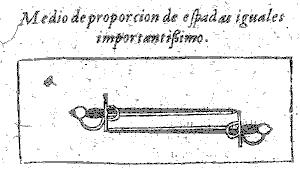
"Measure of proportion when the swords are of equal length - very important" - Pacheco
If the opponent has a longer weapon, how you set your own distance should change and your goal becomes to prevent the adversary from closing the distance so that their threat passes the cross of your weapon. The physical size of the adversary is also considered when setting the distance. For example, an opponent with long legs will have a long lunge and the Measure of Proportion will change to compensate.
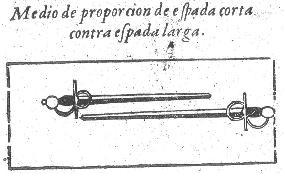
"Measure of proportion for a shorter sword against a longer sword." - Pacheco
When your weapon is longer than the adversary’s your goal in setting distance is to close measure enough to maintain your own Measure of Proportion while violating the defensive distance of your adversary and continually keeping them threatened.
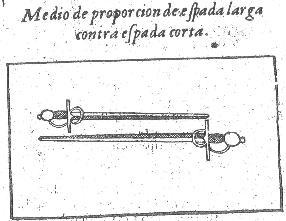
"Measure of proportion for a longer sword versus a shorter sword" - Pacehco
Ettenhard, one of Pacheco’s students, later provides a more nuanced description of this distance which is based on a principle rather than setting defensive measure based on the cross of the sword.
| To choose the Measure of Proportion is to determine a proportionate and convenient distance from which the Swordsman can recognize the movements of his opponent, since for whatever determination of his, there should proceed, of body like of arm and Sword: Of body, by means of footwork: and of Sword, by means of the formation of the Technique. |
Restated, the Measure of Proportion must be chosen so that the fencer can recognize a threat from the adversary. You can anticipate the adversary’s actions if you provide yourself enough distance (and therefore time) to recognize motions of the sword or body.
The Measure of Proportion and the Circle
It is important to remember that all the aspects of the Spanish Circle are defined by setting the Measure of Proportion.
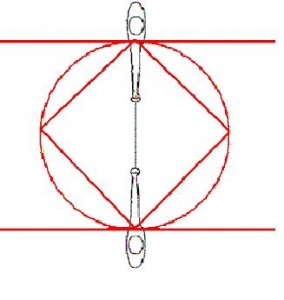
The Measure of Proportion defines the Diameter which also defines the Circle, the Square, and the Lines of Infinity.
You should also note that when two adversaries have a different Measure of Proportion, they will have different preferred Diameters and the circle each wishes to create will be defined differently. This indicates again that arbitrarily “walking the circle” isn’t a reflection of the canonical Spanish tradition. Each fencer will attempt to create a more favorable circle which describes the possible footwork and counter-footwork in a fencing action.
As a common practice “walking the circle” would require not only two identical opponents with identical weapons, but also a choreographed plan in which neither fencer took advantage of the shorter distance gained when the adversary steps along the circle (as shown in Part 2). Instead the opponent would need to continually step away from the adversary to artificially preserve the ideal distance in the circle. Walking around a circle while within the striking distance of a non-cooperative adversary would be dangerous.
In order to close distance by stepping along the circle, the action should either control the adversary’s weapon as you move forward or take advantage of a Movement provided by the adversary (such as the thrust into the diagonal reverse shown in Part 1).
The Proportionate Measure (Offensive Distance or Place)
(En español – Medio Proporcionado )
This is the distance that must be covered to deliver a specific attack. For example the Proportionate Measure of thrusts will be different when using a pike, a sword, and a dagger. By using some of Euclid’s work we can provide a demonstration of which attack and position of the arm has the greatest reach.
The Right Angle
Carranza demonstrates here that the Line from B to A has the greatest reach. This line is called the Right Angle and provides us with effective offense, counteroffense, and defense.
If the blade is lifted from the Right Angle, as shown in the line from B to G, we have entered the Obtuse Angle and our reach has decreased.
If the blade is lowered from the Right Angle, as shown in the line from B to F, we have entered the Acute Angle and our reach has decreased again.
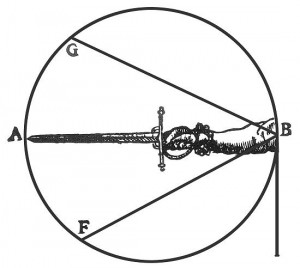
Carranza uses Euclid to demonstrate distance.
The thrust typically has the most reach and will have the most favorable Proportionate Measure. In order to reach the correct distance to execute the thrust you may need to gain control of the adversary’s weapon and step along the Square (Transverse Step) or along the Circle (Curved Step). If the adversary prepares a cut, you can strike with a thrust into his preparation and then quickly retreat. By fencing with an extended arm, the Spanish fencer enjoys an advantage in the number of Movements (and therefore Time) when working against an adversary that cuts.
The Spanish cuts (both full circular cuts and the half cuts) are usually actions that occur when the blade has already moved from the Diameter because of a defensive action or because the adversary has deviated your weapon. These typically have less reach than a thrust but correctly executed can be very powerful. Ettenhard indicates that cuts to the head are more common and that horizontal cuts to the body are dangerous and unusual in practice. Because the Proportionate Measure of a cut is larger than that of a thrust, you should never use the cut as your initial action. The greater number of Movements in the cut expose you to counterattack by the thrust. (Remember that an advantage in the count of Movements is also an advantage in Time.)
The Disarm (Movement of Conclusion) requires you to be close enough to seize the adversary’s hilt with your left hand. This typically requires passing forward with your rear foot and the distance you must travel to successfully execute a disarm can actually carry you to the opponent’s Line of Infinity. Because the Proportionate Measure is greater for the disarm, there is a greater degree of danger involved for a fencer executing the disarm.
Final Notes
Remembering the Terms – The two terms Measure of Proportion (Defensive Distance) and Proportionate Measure (Offensive Distance) can easily be confused. At the risk of being slightly silly, I offer the following mnemonic to help remember the difference between the two.
“When asked of his defense, the aggressive fencer ate his opponent.”
- You can remember defensive measure because it has an ‘of’ in the term – Measure of Proportion
- You can remember offensive measure because it has an ‘ate’ in the term – Proportionate Measure
Angle as Position – The angle of the weapon (Acute, Right, or Obtuse) is a common way of describing the position of the weapon in space. You will see the same anglular terms used to describe position in Destreza texts for different weapons, such as the single sword and even Montante.
Filed as Classical Fencing, Destreza (Spanish swordplay), General, Historical Fencing, Italian Rapier, Movie Reviews, Opinion, Reviews with 12 replies
(8/24/2009)
LINK TO ARTICLE 1
In the Italian tradition there is an imaginary Line of Direction that describes the shortest path to the adversary.
The Spanish tradition uses this line and expands on the concept to create a 2D planar map of possible footwork laid out in a circle. The Spanish Circle is one of the defining elements of the science and various authors have presented it differently while preserving the core concept.
Carranza’s Circle

Carranza’s Circle from his text in 1569.
Here is the same image with labels to provide us a reference.
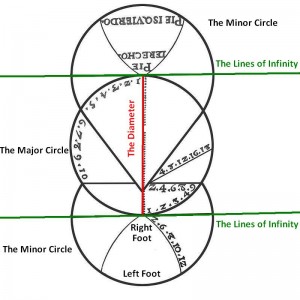
Carranza’s Circle with Labels
The Diameter – The imaginary line separating the two fencers is called the Diameter. It represents the shortest path to the target. The Diameter starts at the lead toe of the fencer (bottom of the red line) to the the lead toe of the adversary (top of the red line). The correct length of the Diameter should be the distance at which the fencer can observe the adversary’s offensive actions and still respond in time.
The Major Circle (Greater Circle) – The central circle shown between the two fencers is called the Major Circle or sometimes just the Circle. By rotating the Diameter about its center, we can create an imaginary circle which functions as a one piece of a footwork map.
The Lines of Infinity– The two parallel lines shown in green are called the Lines of Infinity or Infinite Lines. In the same manner as the Diameter, the distance between these lines is defined by your ability to observe and react to the adversary’s offense. Crossing the Line of Infinity means closing distance into the adversary’s offensive measure.
The Minor Circle – The smaller circles on either side of the Major circle are called the Minor Circles. The fencer and the adversary each stand in the center of a Minor Circle which is defined by the positions of the feet.
The Circle represents a moment of fencing time – The circle is not fixed in location, but instead describes the distance and possible steps within a specific fencing action. Just as the Italian Line of Direction changes when the adversaries move, so to does a new circle occur when the fencers change position. If an adversary has broken your defense and closed measure, the text may advise you to step onto a new circle and this represents the need to reestablish correct distance.
Pacheco’s Circle
Later Pacheco describes a similar circle. Note that the origin point for the fencer is at one end of the diameter (bottom of the circle) while the adversary stands on the opposite side (top of the circle).
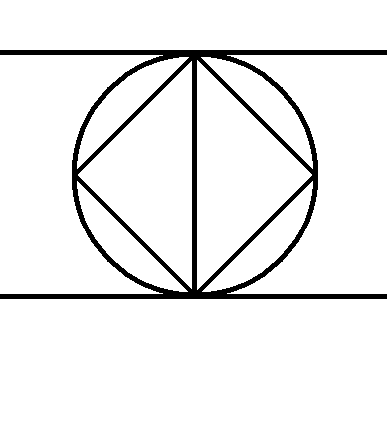
Pacheco’s Circle as shown in his book in 1600.
The primary addition to the Circle is the Square which like the angular lines above in Carranza’s Circle provide us with another indicator for footwork.
We can also map a series of vectors onto this planar diagram which allows us to precisely describe footwork. Remember that a vector is a line with direction and magnitude.

A vector that indicates motion to the right of the reader. (This vector has an undetermined magnitude.)
General Notes
The Spanish treat a step as a motion that starts in stance and ends in stance which requires a motion of each foot. When the fencer moves only one foot, this is specified in the description of the footwork.
To compare this to Italian fencing, we know that an advance starts in the guard and requires a movement from the lead foot followed by the rear foot returning to the guard. Likewise a retreat starts in the guard and requires a movement from the rear foot followed by the lead foot returning to the guard.
By contrast, when an Italian fencer executes a lunge, the fencer starts in the guard and moves only the lead foot. The final position of the lunge is not the guard.
Forward Step
(En español – Compas Accidental )
The fencer advances along the line of the Diameter.
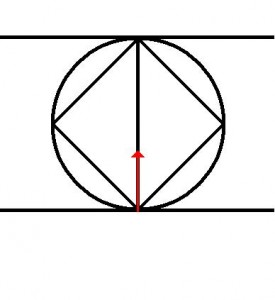
Forward Step (advance)
Backward Step
(En español – Compas Extraño )
The fencer retreats in line with the Diameter.
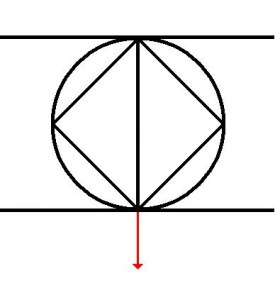
Backward Step (retreat)
Lateral Step
(En español – Compas de Trepidacion)
The fencer steps along the Line of Infinity either to the left or right. When stepping towards a direction, unless directed otherwise, the fencer will avoid crossing the feet. For example, when stepping to the right, the fencer will lead with the right foot. When stepping to the left, the fencer will lead with the left foot.
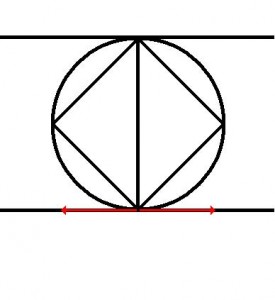
Lateral Step (sidestep)
Curved Step
(En español – Compas Curvo)
The fencer steps along the Circle either to the left or right. When stepping towards a direction, unless directed otherwise, the fencer will avoid crossing the feet. For example, when taking a Curved Step to the right, the fencer will lead with the right foot. When taking a Curved Step to the left, the fencer will lead with the left foot. At the completion of the Curved Step, the fencer should be in profile facing the adversary.
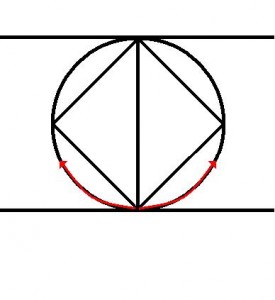
Curved Step
IMPORTANT NOTE: There is a misconception that stepping along the circle does not close distance. This is demonstrably incorrect as shown with this simple triangle in green, purple and blue overlaid on the circle.
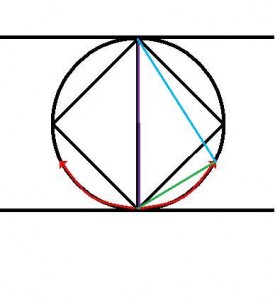
The blue line of the triangle demonstrates the Curved Step has gained measure. The blue line is clearly shorter than the Diameter.
If you step along the circle you should be aware that you have entered the adversary’s range. Walking along the circle without reason provides your adversary with one unit of fencing time with each step and I don’t recommend it.
A Curved Step along the circle is a common method of gaining ground gradually and is often used in response to an offensive action from the adversary.
For example, if the adversary executes a cut, we may intercept the attack with the blade and then step forward along the circle to deliver a riposte. Because the adversary has moved forward already, our step moves only slightly forward and takes us off the line. After we have delivered a riposte, we might back away safely past the Line of Infinity.
Transverse Step
(En español – Compas Transversal)
The Transverse Step is a type of angular advance either to the left or right along the square shown inside the circle. The Transverse starts with the lead foot and is followed by the rear foot. At the completion of the Transverse Step, the fencer should be in profile facing the adversary. When there is an exception to this, it is stated in the description of the step and may be called a Mixed Step (See below).
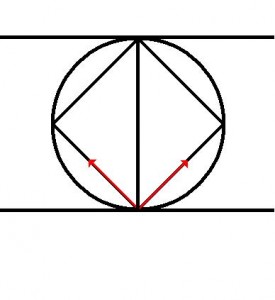
Transverse Step (angular advance)
The Transverse Step closes distance more aggressively than the Curved Step shown above and is typical of offensive actions or attacks into the adversary’s preparation.
Mixed Step
(En español – Compas Mixto)
A Mixed Step is a combination of two other types and are often angular retreats either to the left or right away from the circle.
Two common examples of Mixed Steps are Mixed Backwards and Lateral to the left or Mixed Backwards and Lateral to the right. In this case, the Mixed Step starts with the rear foot and is followed by the lead foot. At the completion of the Mixed Step, the fencer should be in profile facing the adversary.
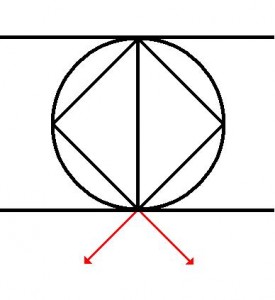
Mixed Step Backward and Lateral (angular retreat)
Another common Mixed Step is the Transverse Step to the Left using the right foot, followed by a Curved Step with the left foot.
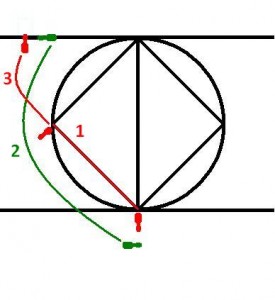
Mixed Step Transverse Left and and Curved Left (angular advance with passing step)
This image is my copy of a Circle from Ettenhard’s book in 1675 which describes the footwork.
1. The lead foot takes a Transverse step along the square pre-turning the lead foot to point back to the adversary. (The weight rests on the ball of the lead foot.)
2. Pivoting on the ball of the front foot, the rear foot moves in an arc landing on the adversary’s Line of Infinity.
3. The lead foot passes behind the left executing another pivot and placing the fencer in profile with respect to the adversary on his Line of Infinity.
Other Footwork
Other footwork is explicitly described in the text.
For example:
The Italian gaining step would be described as “bringing the rear foot forward close to the heel of the right foot.”
The Italian lunge would be described as “an extreme forward step of the lead foot while keeping the rear foot fixed.”
Opposition of Footwork
According to Ettenhard,
- The Forward Step is superior to the Backward Step
- The Forward Step is defeated by the Transverse, Curved, Lateral, and Mixed Backward and Lateral Steps. (Stepping off the Line of Direction will defeat an advancing opponent.)
- The Transverse and Curved Steps can be defeated with the Transverse and Curved Steps. (When an adversary circles toward you, either moving into them or circling away can defeat their action.)
Application to other Traditions
Again this material can be tradition agnostic. Using the Spanish Circle as a footwork map provides us with a useful guide for describing to a student how fast we want them to close measure. We can also advise the student to step inside the square or outside of it provide more nuance.
In addition, the Spanish codify angular and circular footwork which has been largely excluded from modern fencing traditions. As Ettenhard states, countering a circular step with a circular step is a good solution and we see this understanding in Destreza, Aikido, and many other martial arts.
Filed as Classical Fencing, Fencing, General, Historical Fencing, Italian Rapier with 5 replies
(6/3/2009)
This article is a fencing tip for amateur rapier fencers. In Italian rapier and classical fencing the arm is held straight from elbow to tip. Fabris favors an extended and straight arm, but he discusses the sword held at an angle as well.
——————————————————-
Those who hold the sword at an angle (with either the hand in third just above the knee or in second higher and outside the knee) do fortify their sword, but pay the price in giving the opponent much bigger openings and allowing him to come closer.
Fabris’ 1606 text as translated by Tom Leoni
And also this concerning the sword held at an angle:
It is much better to hold the arm withdrawn and the sword straight so as to form a direct line between the elbow and the point.
Fabris’ 1606 text as translated by Tom Leoni
Compare that to this 1997 classical Italian text:
In the completed guard the weight of the body should be distributed equally between the legs, with the torso profiled, and inclining slightly forward, head up and turned to the right, eyes on the adversary, shoulders down, right arm well extended and relaxed, elbow in line with the flank, hand in central position on the line of offense, midway between invitations in third and fourth, and forearm and weapon forming an unbroken line.
Gaugler’s Science of Fencing
——————————————————-
From these two quotes we can see that the Italians are wary of extending a bent wrist forward. A sword that is extended in a straight line from elbow to tip protects the hand behind the guard.
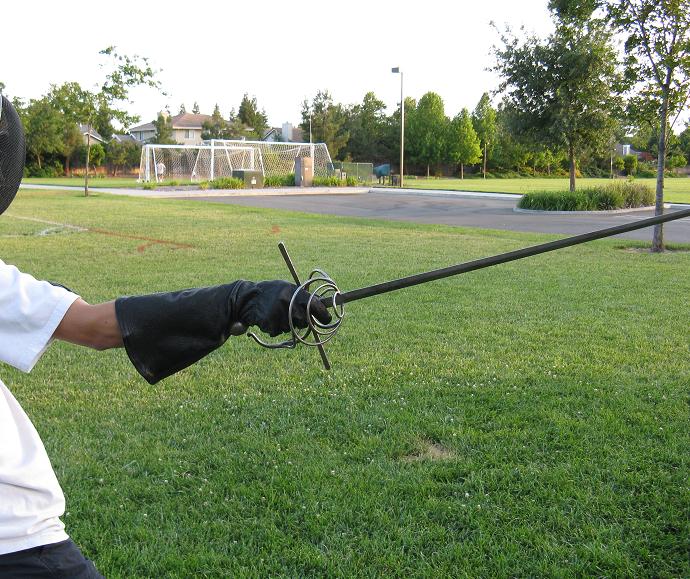
Kevins straight wrist protects his wrist and arm behind the guard.
From the front, the opponent’s perspective is more obvious. (Notice below that the swept hilt protects not only the hand but the entire forearm as well.)
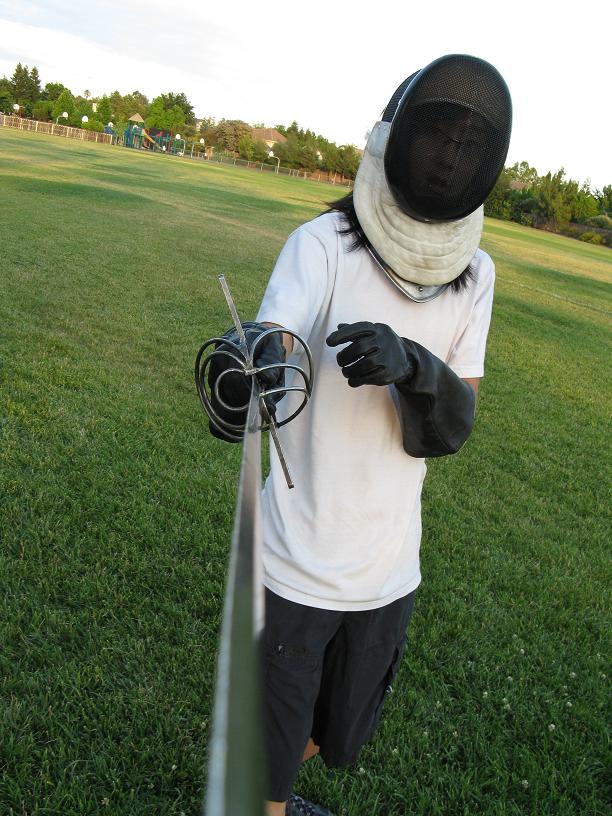
By keeping his arm straight from elbow to tip, Kevin protects his wrist and arm.
Most amateur fencers don’t realize this target is exposed and they open a line to an easy attack that I call Uncle Puck’s Doorway. On a swept hilt rapier there is a V-shaped notch where the rings meet the sweeps and the superior half of the cross.
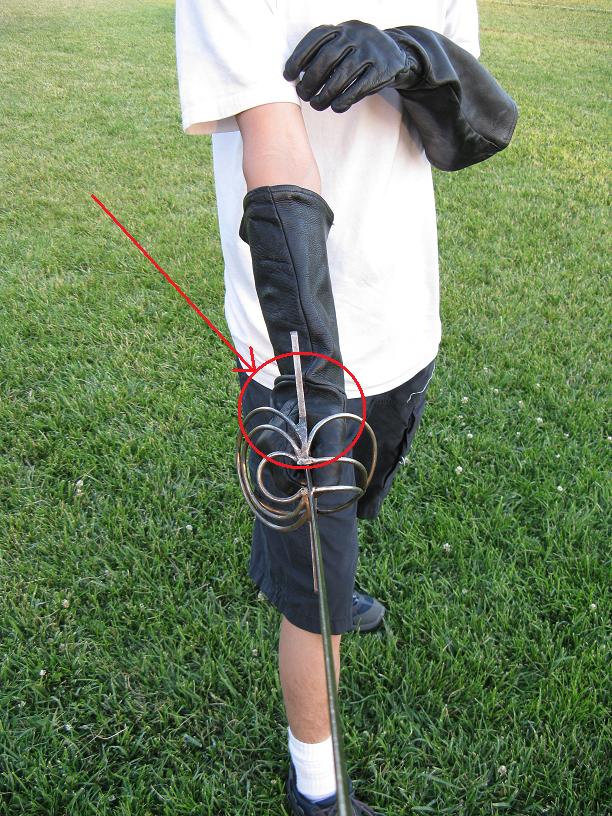
Kevin grips the sword at an angle with a bent wrist showing Uncle Puck's Doorway.
When this angle exists in the wrist, it creates a nice landing pad for an attack to the top of the arm. The bend in the wrist acts as the perfect backstop for the attack.
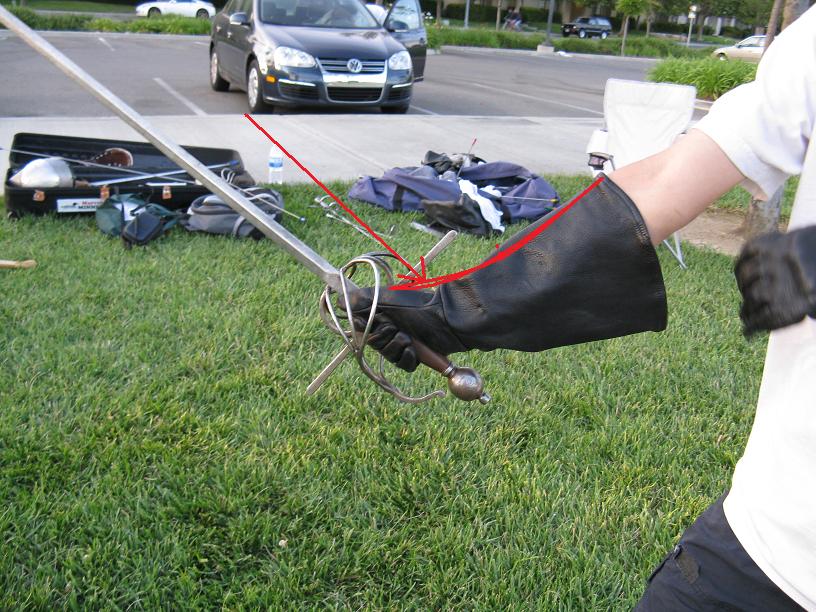
Kevin's bent wrist shows the open door and the angle creates a nice backstop for the attack.
An adversary who holds a sword extended and forward with an angle in the wrist is the gift that keeps on giving. If you are an SCA fencer and you are aware of this line of attack, you can be very effective in tournaments and group combat because newer SCA fencers often make this mistake.
Filed as Classical Fencing, Fencing, General, Historical Fencing, Italian Rapier with 5 replies
2/6/2009
**Phone rings**
Technician: This is Capoferro Tech Support, can I help you?
Caller: Yes, I am currently in a duel and I would like some help.
Technician: Can I get some information about your opponent?
Caller: Sure. He has a sword.
Technician: Can you tell me anything else?
Caller: He’s got black hair and brown eyes.
Technician: [audible sigh]... Can you tell me if he is skilled, unskilled, or bestial?
Caller: How can you tell?
Technician: A bestial fencer will throw many blows with great impetus and has no understanding of tempo or measure.
Caller: I don’t think that’s him; he’s just standing there.
Technician: Does he have his sword out?
Caller: Yes and it is pointed at me.
Technician: Are you within his measure?
Caller: I don’t know.
Technician: Can he currently strike you with a lunge?
Caller: Yes, he’s already hit me twice… I’m bleeding a bit from the shoulder. That’s why I called you.
Technician: You should have told me that first. I need you to immediately retreat out of distance.
Caller: Ok… I have retreated… He seems to have relaxed a bit.
Technician: That’s good. I need to know if your opponent is clever.
Caller: **Loudly aside** Hey, are you clever or what? **Into the phone** He says he isn’t clever.
Technician: I want you to assume the guard and cover the inside line with your blade. Turn your point towards his forward shoulder aligning your edge so that you cover his blade with your strong against his weak.
Caller: Ok… this seems to be working. I think he might be impressed or something. He might even be afraid. I love fencing!
Technician: Now, he should execute a cavazione and try to strike you on the outside high line. Be ready to counterattack by rolling your hand into secunda, closing the line and counterthrusting. Are you ready?
Caller: Ok.
Technician: I want you to gradually move forward with tiny steps directly towards him.
Caller: Ok… I’m taking tiny steps… He hasn’t done anything yet. I think it may be working. Oh oh… he attacked the outside just like you said!! I’m counterattacking!! Ahhhh Ahh ohhh ohhh!! He feinted!! He feinted!! He parried my counterattack!! I’m bleeding again!! Yes.. I’m definitely bleeding!! I hate fencing!! I hate it!!
Technician: Calm down. Calm down! I need you to listen to me. I need you to retreat out of distance again.
Caller: Ok… Ok… I’m retreating. He relaxed again. What would happen if I rushed him? Would that work?
Technician: It would probably work for him.
Caller: What does that mean?
Technician: Don’t worry about it. Here’s what you need to do.
Caller: Ok, I’m ready.
Technician: Are you out of distance?
Caller: Yes.
Technician: Can you see the adversary?
Caller: Yes.
Technician: When you are ready, I want you to repeat after me. Are you ready?
Caller: Yes.
Technician: “I want to sincerely apologize for having offended you.”
Caller: **Loudly aside** I want to sincerely apologize for having offended you.
Technician: Now put your sword away and see if he lets you leave.
***********************************
For the record, covering the inside line and counterattacking the cavazione in 2nd is Plate 7. I’ll leave it to you guys to figure out what the clever fencer’s response was.






















